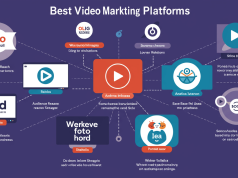Remote work has fundamentally changed how we communicate, collaborate, and connect with colleagues across the globe. What began as an emergency response to pandemic restrictions has evolved into a permanent shift in workplace dynamics, with video conferencing tools now serving as the backbone of modern business communication.
Whether you’re managing a distributed team, conducting client presentations, or hosting virtual training sessions, choosing the right video conferencing platform can make or break your remote collaboration efforts. The market offers dozens of options, each with unique features, pricing structures, and capabilities that cater to different business needs.
Why Video Conferencing Tools Matter More Than Ever

The statistics speak for themselves: remote work has increased by 159% since 2009, and 42% of the U.S. workforce now works from home full-time. This dramatic shift has placed unprecedented importance on digital communication tools that can replicate the spontaneity and connection of in-person interactions.
Effective video conferencing goes beyond simply seeing faces on a screen. Modern platforms integrate screen sharing, collaborative whiteboards, breakout rooms, and recording capabilities that transform virtual meetings into productive work sessions. The right tool can reduce email chains, accelerate decision-making, and maintain team cohesion across time zones.
However, the wrong choice can lead to technical difficulties, security vulnerabilities, and frustrated participants who struggle with poor audio quality or complex interfaces. Understanding what separates excellent video conferencing tools from mediocre ones is essential for any organization serious about remote collaboration. Explore this Video Content Marketing Guide.
Top Video Conferencing Platforms Compared
Zoom: The Market Leader
Zoom has become synonymous with video conferencing for good reason. The platform combines reliability with user-friendly design, making it accessible to both tech-savvy professionals and those less comfortable with digital tools.
Key strengths include crystal-clear audio quality, stable connections even with slower internet speeds, and intuitive meeting controls. Zoom’s breakout room functionality excels for team workshops and training sessions, while its recording capabilities make it easy to share meetings with absent colleagues.
The platform offers flexible pricing tiers, from a free basic plan supporting up to 100 participants for 40-minute meetings, to enterprise solutions with advanced security features and unlimited cloud storage. Integration with popular productivity tools like Slack, Microsoft Teams, and Google Workspace streamlines workflow management.
Microsoft Teams: The Collaboration Powerhouse
Microsoft Teams positions itself as more than a video conferencing tool—it’s a comprehensive collaboration platform that integrates seamlessly with the Microsoft 365 ecosystem. Organizations already using Word, Excel, and PowerPoint will find that Teams offers unparalleled integration capabilities.
The platform’s strength lies in its ability to combine video calls with file sharing, real-time document editing, and persistent chat channels. Teams supports up to 10,000 participants in meetings and offers advanced features like live transcription, background blur, and Together Mode for more engaging group discussions.
For enterprises heavily invested in Microsoft products, Teams provides exceptional value through bundled licensing and unified management across all Office applications.
Google Meet: Simplicity and Security
Google Meet emphasizes simplicity and security, making it an excellent choice for organizations prioritizing ease of use and data protection. The platform’s browser-based approach eliminates software installation requirements, allowing participants to join meetings with a single click.
Security features include encrypted video calls, meeting locks, and admin controls that prevent unauthorized access. Google Meet integrates naturally with Google Workspace applications, enabling seamless scheduling through Google Calendar and file sharing via Google Drive.
The platform supports up to 250 participants in premium plans and offers features like live streaming for up to 100,000 viewers, making it suitable for large-scale webinars and company-wide announcements.
Cisco Webex: Enterprise-Grade Security
Cisco Webex targets enterprise customers with advanced security requirements and complex organizational structures. The platform offers end-to-end encryption, compliance with government security standards, and granular administrative controls.
Webex excels in large-scale meetings and webinars, supporting up to 100,000 attendees with features like polling, Q&A sessions, and detailed analytics. The platform’s AI-powered features include real-time translation, noise removal, and automated meeting summaries.
While Webex may feel overwhelming for small teams, enterprise organizations appreciate its robust feature set and enterprise-grade security capabilities.
Essential Features to Consider
When evaluating video conferencing tools, several key features determine the platform’s effectiveness for your specific needs.
Audio and Video Quality: Poor audio quality kills productivity faster than any other technical issue. Look for platforms that offer noise cancellation, echo reduction, and adaptive bandwidth management that adjusts quality based on connection strength.
Screen Sharing and Collaboration: Modern meetings require more than talking heads. Effective screen sharing with annotation tools, multi-screen support, and collaborative whiteboards enables productive working sessions rather than passive presentations.
Recording and Playback: The ability to record meetings and share them with absent team members extends the value of every session. Consider platforms that offer cloud storage, automatic transcription, and easy sharing capabilities.
Security and Privacy: With increasing concerns about data privacy, look for platforms offering end-to-end encryption, waiting rooms, meeting passwords, and administrative controls that prevent unauthorized access.
Integration Capabilities: Your video conferencing tool should integrate seamlessly with existing productivity software. Calendar integration, file sharing capabilities, and API access reduce friction and improve adoption rates.
Mobile Experience: Remote work often means working from anywhere. Ensure your chosen platform offers full-featured mobile apps that don’t compromise on functionality or user experience.
Making the Right Choice for Your Organization

Selecting the ideal video conferencing tool depends on your organization’s size, budget, security requirements, and existing technology stack.
Small businesses and startups often benefit from platforms like Zoom or Google Meet, which offer generous free tiers and straightforward pricing structures. These tools provide essential features without overwhelming users with unnecessary complexity.
Medium-sized organizations should consider how video conferencing fits into their broader productivity ecosystem. Microsoft Teams makes sense for companies already using Office 365, while Google Meet suits organizations built around Google Workspace.
Large enterprises with complex security requirements and compliance needs may find Cisco Webex or enterprise-tier Zoom plans better match their needs, despite higher costs and steeper learning curves.
Transform Your Remote Communication Strategy
The video conferencing landscape continues evolving rapidly, with new features and capabilities appearing regularly. Artificial intelligence integration, virtual reality meeting spaces, and advanced analytics represent just the beginning of what’s possible in digital collaboration.
Success with any video conferencing platform depends not just on the technology itself, but on how effectively your team adopts and uses it. Invest time in training, establish meeting etiquette guidelines, and regularly gather feedback to optimize your virtual collaboration experience.
Start by identifying your organization’s specific needs and trying free trials of platforms that match your requirements. The right video conferencing tool will feel invisible, enabling natural communication and productive collaboration without technical barriers getting in the way.









